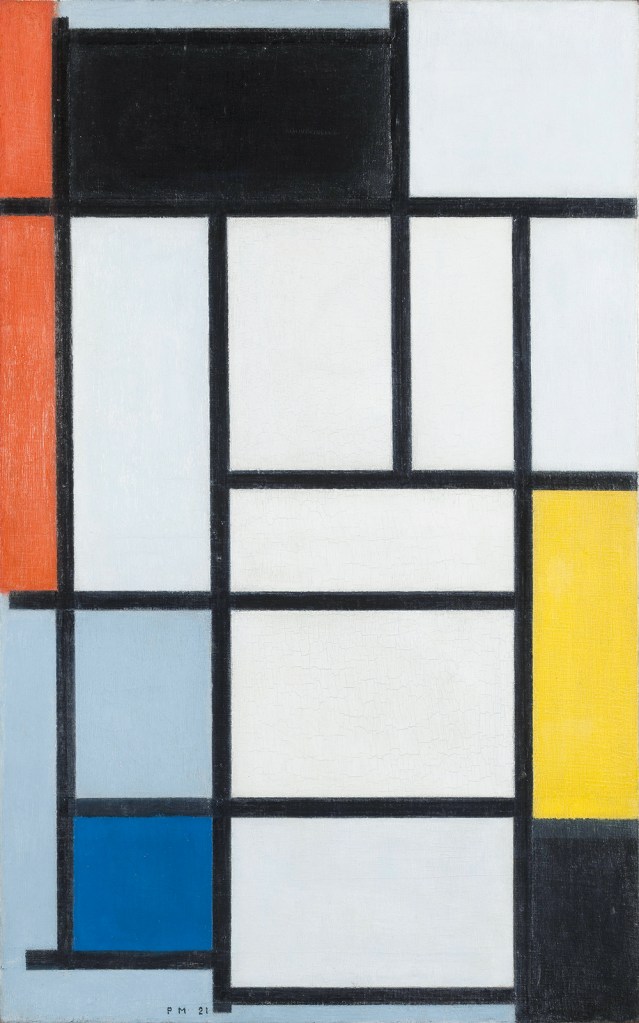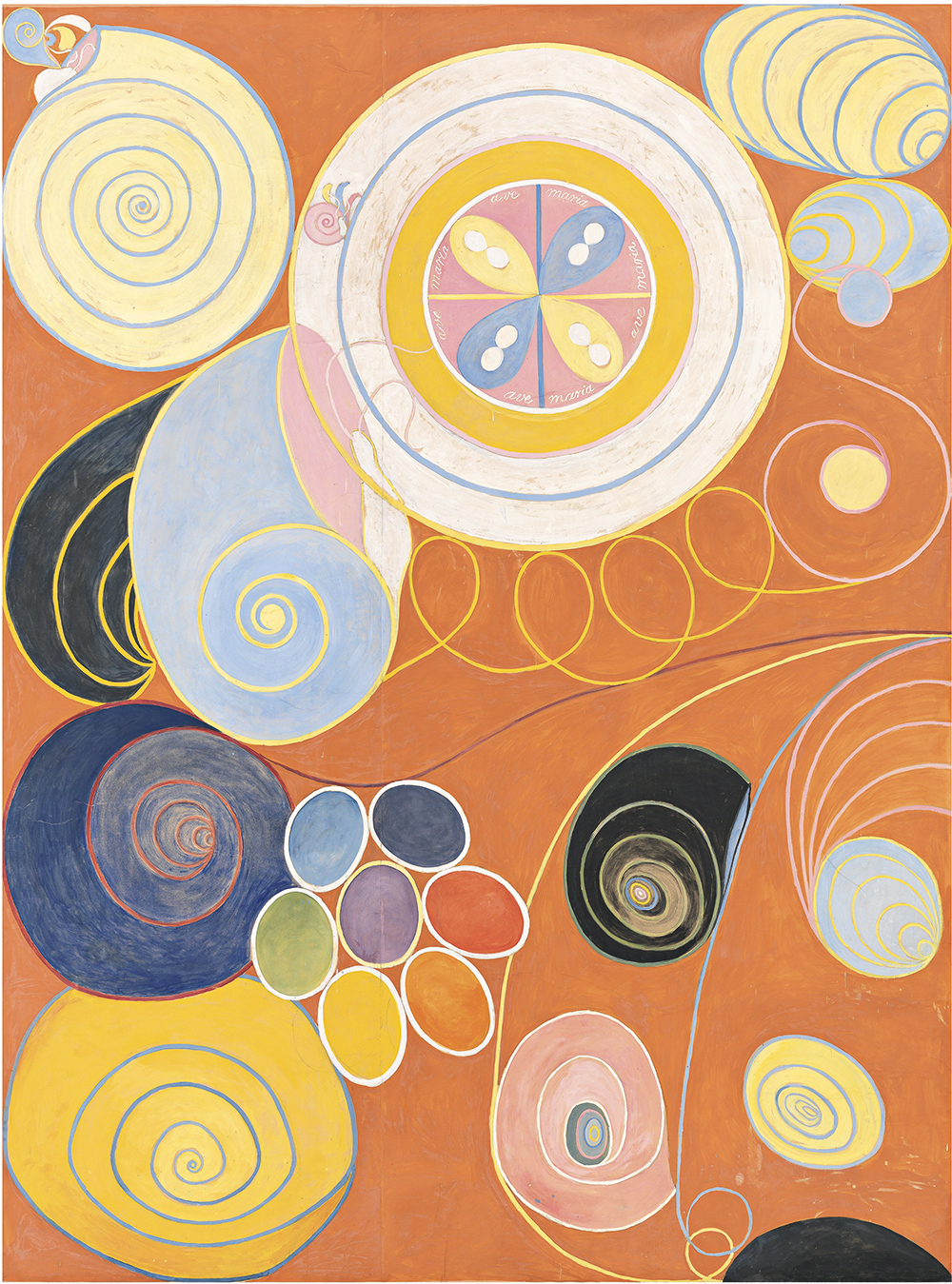In July 1928, an unknown Swedish woman artist mounted a solo show of her revolutionary abstract paintings at the World Conference on Spiritual Science in London. It was a moment the 65-year-old Hilma af Klint had waited a long time for, but her confident prediction 20 years earlier that ‘the experiments I have undertaken will astound humanity’ was not fulfilled. So deafening, in fact, was the critical silence that greeted her work that she left instructions for it to remain under wraps until 20 years after her death. The world wasn’t ready for her ‘future pictures’.
Entering the room devoted to Mondrian’s signature grids, you could be in a different exhibition
What a difference a century makes. When the New York Guggenheim took a punt on a solo exhibition of Af Klint’s work in 2018 it attracted more than 600,000 visitors, an attendance record. Now she has been given joint billing at Tate Modern with the greatest and most abstract of abstract painters, Piet Mondrian.
Although their forms of abstraction could not look more different – Mondrian’s all straight lines and primary colours, Af Klint’s all biomorphic curves in rainbow hues – the reasoning behind their pairing is that both artists arrived at abstraction through the study of nature combined with esoteric beliefs in a higher reality. Both started out as traditional representational painters – Mondrian’s ‘Evening Landscape with Cows’ (1906) in the opening room is a perfect match for Af Klint’s ‘Spring Landscape from Lomma Bay’ (1892), down to the distant cattle – and both became theosophists, Af Klint in 1904, Mondrian (ten years younger) in 1909. A room of flower paintings shows them continuing to work in tandem, though Af Klint’s watercolours of native weeds and grasses are botanical studies and Mondrian’s paintings of single cultivated flowers are far more expressive, his dying ‘Chrysanthemum in a Bottle’ (after 1921) not just wilting but weeping.
Their paths to abstraction, too, were very different. Mondrian caught cubism in Paris in 1912, incubated it in Amsterdam during the war and developed his own strain of ‘neo-plasticism’. His brand of spiritualism was more pragmatic: recognising that we live ‘in the realm of the normal senses’, he believed that art could become ‘a transition to a finer realm’ and hoped that abstraction would help him get there. Af Klint took it all a lot more seriously. While conducting seances with a group of women friends in the 1890s she had begun receiving messages from ‘High Masters’, one of whom instructed her in 1906 to create a series of ‘astral paintings’ and a temple to house them. From then on, artistically speaking, she was on her own.

Completed under the spirits’ guidance nine years later, Af Klint’s ‘Temple’ cycle ran to nearly 200 works. Some, like her ‘Evolution’ (1908) series, contain human and animal figures; others, like her ‘Tree of Knowledge’ (1913) series, feature sinuous forms derived from art nouveau. Her ‘Swan’ series (1914) is the most geometric, but her most dramatic works in scale and ambition are ‘The Ten Largest’. Painted by the 5ft tall artist on 10x7ft sheets of paper in a few frenetic months in 1907, they describe nothing less than ‘the path of the soul from the beginning of the spectacle of life to its end’. With their giant biomorphic forms in dolly-mixture colours, they close the exhibition with a party-popper bang.
Hitching these two artists together like the yin and yang of abstraction does neither of them any favours
In the wake of scientific discoveries in the 1890s of invisible forces from electromagnetic waves to radiation, the existence of higher worlds beyond the reach of human perception seemed to enter the realms of possibility and spiritualist movements became big business. Like many artists and writers, Mondrian and Af Klint became converts to Rudolf Steiner’s anthroposophy; both tried to interest Steiner in their artistic theories and both were given the brush-off. Af Klint was bitterly disappointed by his lukewarm reaction to the suitcase of reproductions she lugged all the way to his Goetheanum in Dornach in 1922, but when Mondrian’s letter explaining neoplasticism went unanswered by the great man he took it on the chin. He didn’t need Steiner’s approval of his artistic project; he knew exactly what he was doing.
Entering the room devoted to Mondrian’s signature grids, you could be in a different exhibition. There’s a sureness of touch about these arrangements of lines and colours that feels inevitable: they have an authority you can’t argue with. Mondrian explored the occult ‘to understand things better’ but when he painted it was with the physical eye. Af Klint painted with the mind’s eye, attempting to see beyond appearances to ‘what lies behind everything created’. When you look at her compositions you wonder what they mean; when you look at his you wonder how they can possibly achieve such perfect dynamic equilibrium. Hitching these two very different artists together like the yin and yang of abstraction does neither of them any favours. They’re an odd couple.







Comments